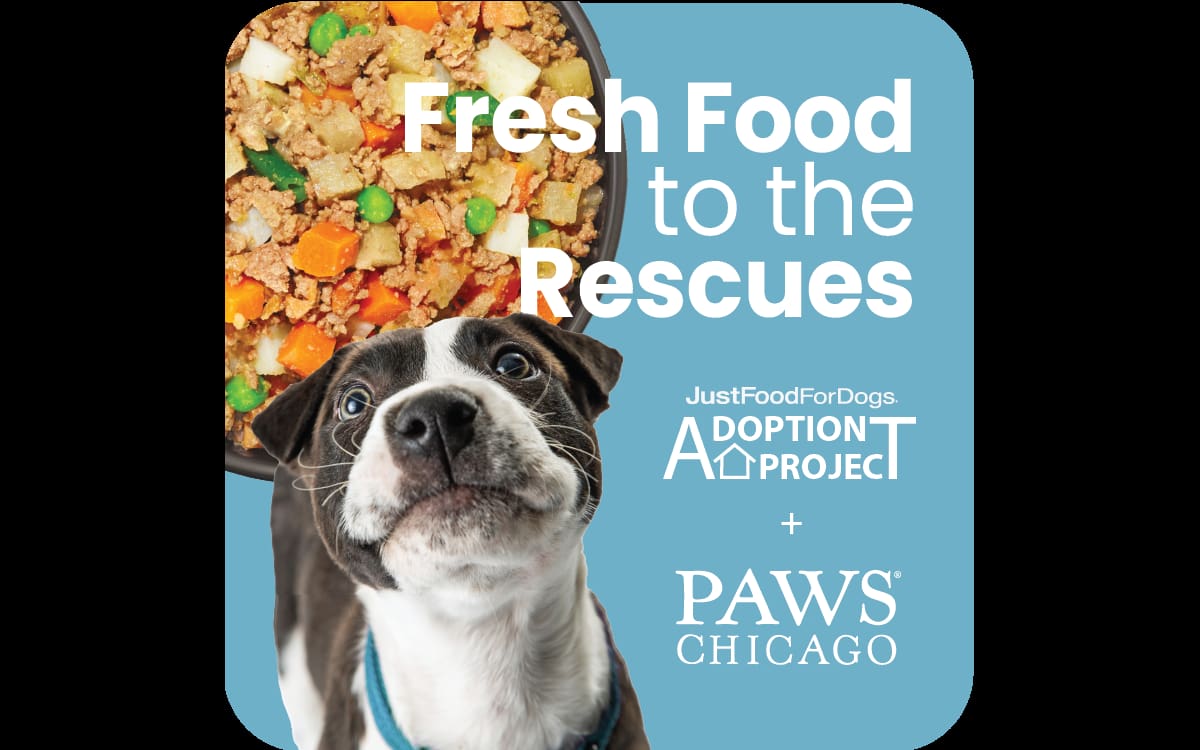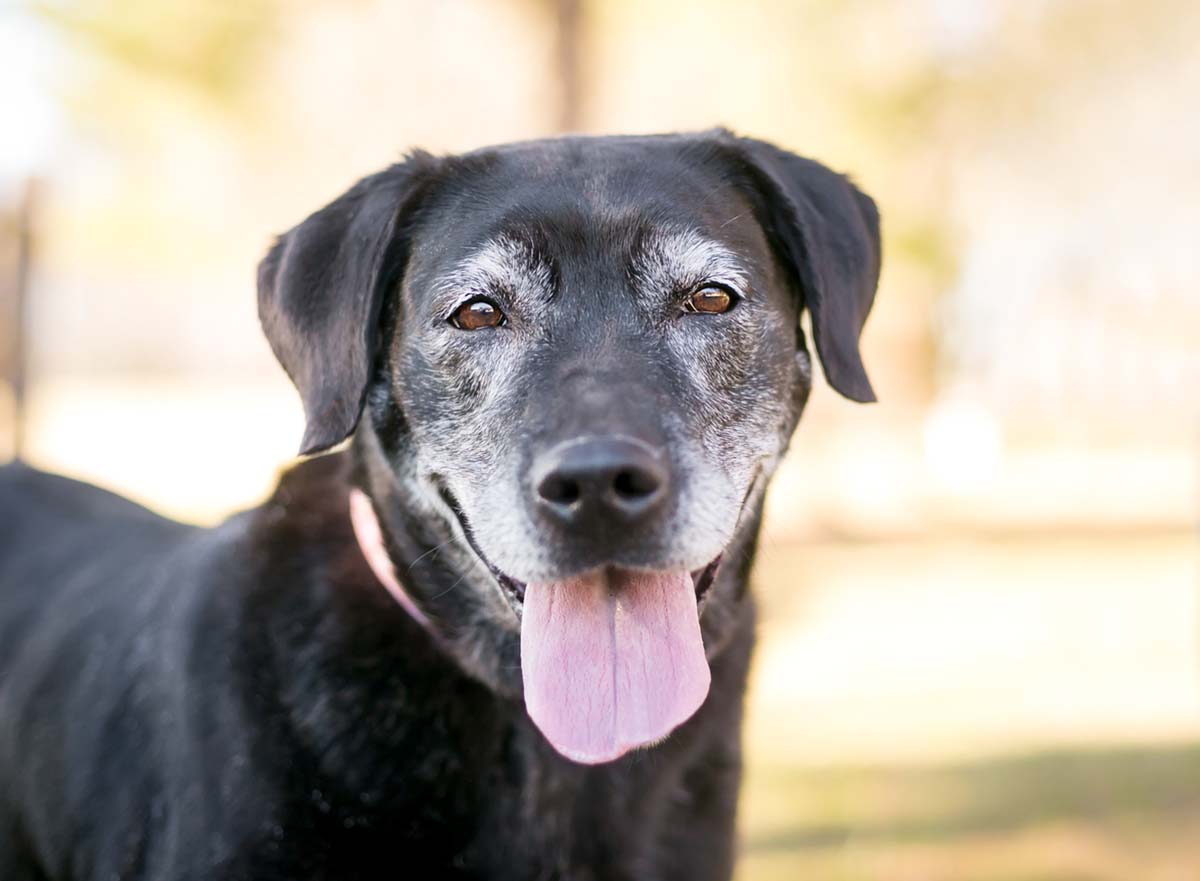AP Rescue Partner Spotlight: Muttville
Sherri Franklin talks about Muttville, senior pet wellness, and her mission to save as many senior “mutts” as possible.
By Natalie Lykins
The big, yellow “Muttville” sign is a beacon of joy on an otherwise drab street in the heart of San Francisco. The metal gate is adorned with flowers, clouds and a dog basking in the sun. It is evident from the exterior that happiness and hope await you inside.
Sherri Franklin has created a world inside of Muttville where even the saddest, down on their luck senior pups have a second chance at life. I sat down with Sherri to learn more about Muttville, senior pet wellness, and her mission to save as many senior “mutts” as possible.
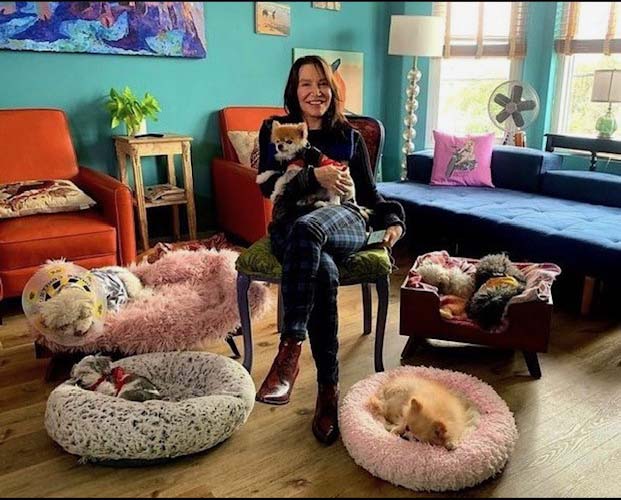
Muttville is a very special place. It has set a new standard for animal wellness, both physical and emotional. How did the concept of Muttville come to be?
Muttville started at my house, and I was here with a lot of volunteers for about five years. In that time, in that first year I saved 27 dogs and placed all these senior dogs that were on euthanasia lists. I thought that was a win because I wasn’t sure if we were going to be able to celebrate a bunch of successes or if I was just going to become a hoarder of senior dogs, which was not my plan.
I really started working right away with foster homes, and this was pre-Facebook, pre-internet and social media, so everything we were doing was with posters with tears-offs. We put them in veterinary offices, supermarket cork boards and we taped them to things. That’s how we got the word out back in the “old days”. I pretty much opened up my house to all these new people that I was just meeting.
People ask, “How did you do it?” and I don’t really remember because I was just going, going, going. I didn’t have time to really think about it. And there was such a need, you know? The first year, we only rescued so many dogs, but we moved quickly up to saving over 100 dogs a year. Now we are saving over 1,000 a year. Learning how to maneuver and learning how to do all this, all with volunteers. I didn’t get paid. they didn’t get paid. We were just doing this for the love of the dogs. Which we still do, but now, thank God, we actually get paid to do this because it’s a full-time job. It’s seven days a week for me. It’s a labor of passion for all our staff and all our volunteers. It is all about the dogs. In fact, our chant is “Dogs! Dogs! Dogs!” That is what it’s about. It’s setting up these dogs for success. Some of them were neglected their whole lives and, you know, to get them to smile and know what love is… it creates a real community around that because so many people are also “rescued”.
I want to say we are all rescued because of dogs too, right? I think back in 2007 there was no such thing as a senior dog rescue. There were a couple of sanctuaries in the nation, but there was not an organization really marketing the viability of adopting out senior dogs and how great they are in a home. Those kinds of things that weren’t really talked about. They were throw-aways, more-or-less. I like to think of us as a community, rather than one place. I named it “Muttville” because I wanted it to be a land you could go to. It was not just a shelter, it was really a special place you could go to and find happiness.
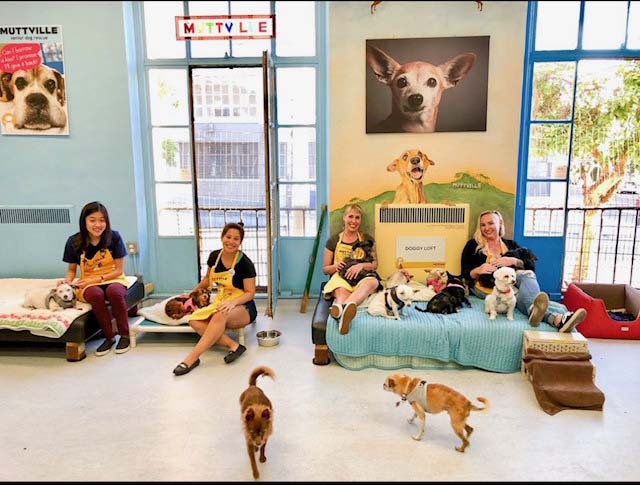
Your facility is extremely welcoming and comforting. It almost feels like walking into someone’s living room. You truly broke the mold by becoming the first cage-free facility in the nation. How do you think this affects the well-being of the “Mutts” in your care?
Well, number one, it keeps them more adoptable. If you have a dog living in a kennel for weeks on end, they start to go a little crazy, they lose their sociability… even if they get out on a walk, it’s not enough.
When we found our space, when the San Francisco SPCA offered up their old offices, we had space to grow out of my house, and I wanted to create a shelter that felt like my home, with cozy beds and sofas. A comfy place for humans and dogs! Knowing that a dog is not sleeping in a cage at night or in a kennel, I think it not only helps with keeping them socialized, but I also think it’s healthier. I think dogs get sicker in kennels. That’s why it’s called “kennel cough”. It’s the stress of being in a kennel that creates more illness. You’re keeping a dog healthier by virtue of just having them be social and happy, just like humans. When you get unhappy, you get sick. It goes hand-in-hand. So, it keeps them adoptable, it keeps them healthier, and on top of all of that, we are able to tell an adopter a lot more about the dog’s personality when you see them in a foster home.
We are basically foster-based. We have 70 dogs in foster homes and maybe 20 at our shelter at any given time so we are really moving them into foster homes very quickly. But as far as people adopting a dog with more information, I mean why wouldn’t you want to know more about your dog? How is it in the house? Is it a counter surfer? Well, at least you know it’s a counter surfer in advance rather than finding that out later. I have a counter surfer here, but I can tell somebody “Just make sure you push everything back on the counter before you bring your dog in”.
Being cage-free and being foster-based was always part of the plan and we have worked out a lot of kinks over the years. I mean, we are going on 17 years, so I like to think we really started a movement. I think people are seeing that it can be really successful. And yes, not all dogs can fit into a cage-free environment. We do have separate rooms and different offices where single dogs can be if we find that they just don’t thrive with other dogs. We try to move them into foster homes more quickly if they are bigger or if they maybe aren’t great in a group of animals. Certainly, it’s not for every situation, and we do have kennels for our ISO dogs because it’s important to have that area where you can separate a dog that comes in sick or gets sick.
We also have a foster program, “Mutts on the Mend”, where we send out dogs to homes that don’t have other dogs, so we can get some of these dogs who are sick into homes. I think we created something new, and I think people are seeing that it can work.
It is very apparent when you walk into Muttville that every single person in that building is so happy to be there, both staff and volunteers alike. Everyone is very warm and joyful, and their level of commitment to the Mutts is obvious. At a time when there is such a drought of dedicated fosters and volunteers, how do you think you have been able to form such a tight-knit Muttville family?
That is such a great question. We actually just spoke at the Best Friends conference in Texas this past week about how we keep our volunteers and our fosters. I think it boils down to creating community and letting people become a part of the process. When you have a foster who is really committed to their foster dog, they should be a part of the process of the adoption. They should meet with the adopter. They should feel the reward of saving that dog as much as Muttville does because we can’t do it without fosters. It’s about bringing people in and creating a community where it’s not us and them, or the staff versus the fosters.
It’s really about the fosters getting the win, too. I learned this early on because I was a volunteer and a foster family for other organizations for years before I started Muttville, and it never felt like I had any control over where the dogs went. They went back to the shelter for adoption days, and I wouldn’t see that dog again. When I was a volunteer, I had so many rules and so much rigidity in the way I could be at the organization. It wasn’t like I was part of the team. It was more like I was doing their bidding. At Muttville, you are a part of the team. The minute you come in you are going to be doing things. You are not only going to be walking dogs, but you are going to be cleaning up poop like the rest of us. You are going to help feed. You are going to help medicate. We are allowing our volunteers to really feel like they are making a difference. And they are. They are making a difference. We couldn’t do it without our volunteers and our fosters. We couldn’t save lives. I think people keep coming back because they feel well cared for, and they get to feel the reward of their dogs getting adopted.
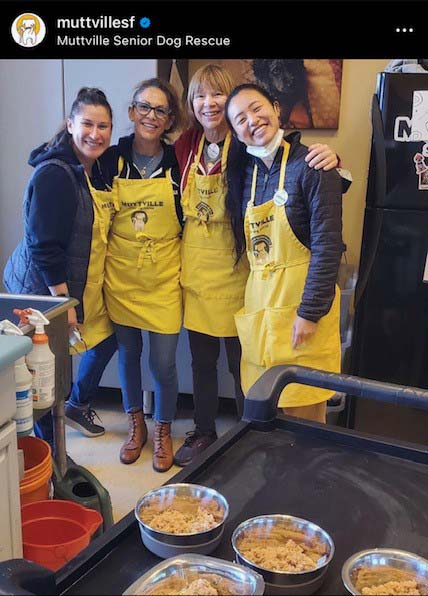
Muttville is very well known for its Seniors for Seniors program. Why do you feel a program like this is so beneficial?
There are a million reasons. About 30% of our adopters this year are seniors. I think we have created the buzz around that. I think that seniors need that unconditional love, that reason to get up in the morning, and that community more than anybody.
Now, bringing a puppy into a senior home probably is not the best idea at all, not for the dog and not for the senior. It depends on the senior, or whatever you consider senior… our senior, seniors. I don’t feel like we should have boundaries around that. I mean, there are seniors that absolutely cannot support a dog in the way that it needs to be. Like, they can’t walk it. But it works if you have a support system. I had a 100-year-old woman adopt a dog and she has a support system that takes the dog out for a walk, but she also goes out in her walker still with her dog, and it’s keeping her alive. It keeps her from not wanting to get up in the morning. She wants to get up in the morning.
We have created a community of seniors that we call “Cuddle Club”, made up of seniors that can’t have dogs or unfortunately feel like they can’t have a dog in their life. They come to Muttville once a week and they walk the dogs together, they cuddle all the dogs that are at the shelter at the time, and it’s sort of like they are volunteering, but they are also getting their dog fix in. You get to see this love that happens. We have had grumpy old men and women come in wheelchairs and they don’t even smile when you say hi. But the minute you put a dog in their lap they are laughing and having conversations. Dogs and seniors are so perfect together.
As far as Muttville and senior dogs go, we get a lot of dogs from senior citizens. Unfortunately, sometimes a senior goes into a nursing facility and can’t have a dog anymore or passes away and can’t have their dog anymore… we get their dogs. We get a lot of dogs that have come from a home with a senior, so it’s a really good match to place one of these dogs in a home with another senior. Families bring in their mothers, their grandmothers, or their great aunts, so it becomes a family affair to pick out the dog. It’s really sweet. The stories we get are amazing. The people that write back and tell us the journey of the dog and the father who was a curmudgeon and never liked anybody, and now he knows all the neighbors… things like that start to happen when you have a dog.
You also have a very successful hospice program. One would think it would be difficult to find people who would be willing to take on dogs who have terminal illnesses. What do you think draws people to this program?
I am drawn to that program, so I can speak to that. I bring home hospice dogs often. We adopt out these dogs as hospice dogs. We support their palliative care, which is pain relief, if a dog has an ear infection, things like that. Of course, that is a “quality of life” thing that we can fix.
What draws people to it, and I am one of those, is knowing that we get to give this great gift of love and fun to these dogs that still have a positive quality of life. They don’t know they are sick, you know? We get to give them that until their quality of life is diminished and they are suffering, and then we get to give them the gift of euthanasia, which is a gift at that point, too.
Some of our hospice dogs get adopted more quickly than our regular dogs because people know, when one goes, we rescue another. It is a really rewarding experience for the right home. We have families that have decided, with their kids, to take home a dog in hospice as well, so it’s not just for the older person. It can be a beautiful thing. We get some responses like “I don’t want to put my child through losing an animal” and then we get the other people that say, “I really want my daughter, son, or family to experience this in a positive way”.
Going in, knowing their time is short, let’s make it fun, let’s make it joyful, let’s live in the moment. It teaches you a lot. I want to be one of my dogs when I get old. I don’t want to suffer either. I want pain meds and then I want somebody to say it’s my time because I’m suffering. I kind of feel that humans don’t always fare that well at the end of their lives.
By specializing in senior Mutts, there is a high probability that medical care outside of the routine will be needed. How does Muttville handle the medical necessities for all the Mutts?
Well, we do have a full-time vet staff. We have volunteer veterinarians that come in weekly, and we have a full-time vet that we employ. We have three vet techs, we have a dental specialist… we have a full clinic. Having all that has helped us save money, believe it or not.
You’re right in that when dogs come to us, a lot of them have been neglected their whole life. I would say 90% of our dogs need dental care. We have had many dogs come in that need full mouth extractions of every tooth in their mouth because they are so rotten. These are the things we like to take care of before a dog is adopted. We want to set up that dog to have quality of life, and with a mouth full of rotten teeth, it’s not going to happen.
Bringing that in-house, of course there was an up-front cost, but now we see our budget for that coming down. We are always looking at the data as well to see how we can do everything. We still can’t afford to do everything, but we can afford to make sure that we can get their mouth clean, remove a massive tumor, or do amputations, for instance. We do lots of different kinds of surgeries, and we have a surgery suite, so we are doing as much in-house as we can prior to adoption.
Some of these older dogs might end up with something that will cost a lot of money. That’s when I say, “have a discussion with your vet”. Certainly, the dental should happen, and if a dog has seizures, seizure medication should happen, but do you need to do an MRI or a brain scan on a 13-year-old dog to see what the seizures are about? No. I wouldn’t do that. A vet may suggest that, but I think having a really honest conversation about where you draw the line, how much you can afford, what fits into your budget, and how you make your dog comfortable, happy and pain free, versus spending $15,000 on test that are going to show the dog has an inoperable brain tumor. We need to have these conversations instead of just saying “Yes, I want to do it” or “No, I can’t”. Have a conversation about how I can make my dog happy now. What can I do to give this dog the comfort and the love now, versus feeling guilty that you can’t do an MRI.
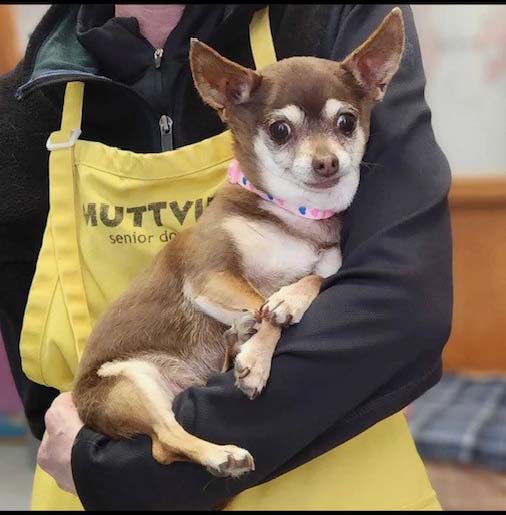
You are telling me my own story. I had a senior pug, and at 12 years old he suddenly started having seizures weekly. I brought him to the emergency clinic and we discovered that there was a mass in his nasal cavity that was starting to push back against his brain. That left us with two options: We could either do all the expensive biopsies and diagnostic procedures that would cost thousands of dollars and would, most likely, not change the outcome for him at 12 years old. Or we could do whatever would keep him happiest and most comfortable in the time he had left and release him from his discomfort when it was time, and that is what we did.
I think we are opening a new door in veterinary care and to the public, talking about how it’s okay that you didn’t do the MRI. I feel like there was a time when you would feel so guilty if you didn’t throw absolutely everything into your dog. Think about what your dog would go through during that surgery. Think about the recovery for a 12-year-old pug from the surgery itself, and then your pocketbook, for sure. I took out loans in the past for dogs who needed surgeries, so I know what that is like. I think we are entering a stage where, first, there Is a veterinary shortage, and when you think about the shortage of veterinarians, and you start thinking about how you want your dog to be comfortable… a great last chapter… let’s choose hospice. Let’s choose something a little less invasive.
Speaking of making dogs happy and comfortable, as dogs age, it can sometimes be difficult to get them to eat, whether it’s from not feeling well, general disinterest or painful teeth. How have the fresh food meals provided by the JustFoodForDogs Adoption Project changed mealtimes at Muttville?
Well, I can speak for myself with all my hospice dogs and my hospice fosters that I have waiting for adoption. JustFoodForDogs is the first food that all my dogs like. I used to have like, five different kinds of food, and ten bowls and I would go “this one likes this, this one needs a little topper, this one likes this”, and now I only use JustFoodForDogs and I don’t need any toppers. That has been amazing. They especially love the Turkey & Whole Wheat Macaroni recipe. The other thing I really like about it, and this is just me being very real about the fact that dogs often poop in my house, is that I don’t have diarrhea in my house anymore. I don’t have to tell you that waking up in the morning to a dog that has sprayed diarrhea all over your house and walked through it in the middle of the night is not fun. Not having diarrhea is a really nice thing for me.
Another thing that I find wonderful about the food is how healthy it is. A lot of dogs come in with anemia or bad liver values and kidney issues, and we see a lot of positive bloodwork come back after they start eating JustFoodForDogs. We do regular follow up bloodwork after three weeks or a month and we see positive changes in those dogs. For these old guys, and I am talking just ages seven and up, I feel like it’s given them the opportunity to get well.
That makes us so happy to hear. We are so honored to be able to do this for you. It truly makes us so happy.
We love it! Our dogs love it! Trust me, when you are feeding 25-30 dogs at the shelter, and you have to feed them all different food because they don’t like things… it is really nice to have something they all like.
What misconceptions about senior dogs do you most want to change?
That they are just going to be a problem, and that they are not going to add value to your life. The thought that they can’t love another person, or that they are too old to make change. These dogs are so loving, so grateful, and add so much joy. Finding the right match for you is what is important. We get old dogs that love to go on a hike, just maybe a shorter one. And then we have ones that just want to sit in your lap. At Muttville, and I think at most senior rescues, we do a great job at matchmaking the senior with the senior, or the senior with a family that doesn’t want a young puppy. We get those too.
If you would like more information on how you can support Muttville Senior Dog Rescue, please visit www.muttville.org
Follow them on social media: @muttvillesf
Natalie Lykins is the manager of the Adoption Project. She has an extensive history in animal care, having volunteered with many rescue organizations since her early teens, and previously worked at a vet clinic. She has found her true mission at JustFoodForDogs and, according to her, would not want to be doing anything else.






